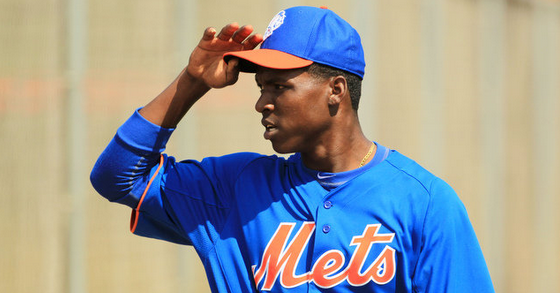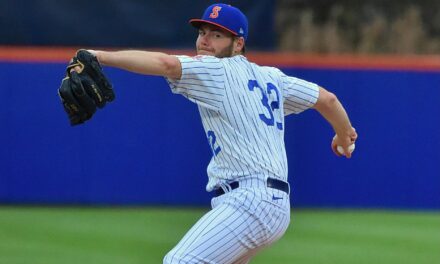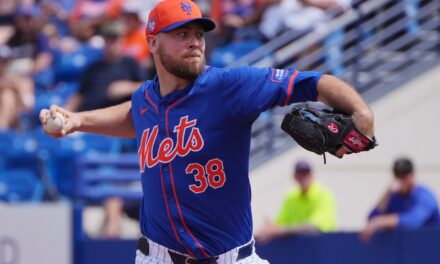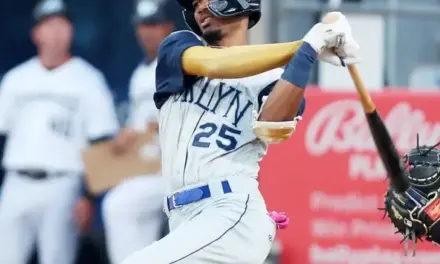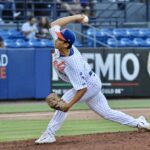Sometimes the anticipation and the pre-game excitement outshines the actual event. That was the case with my trip to NYSEG Stadium to watch the Binghamton Mets last night. For starters, the B-Mets were hot, matching a franchise record with 14 wins during the month of April.
The upstate New York weather was unreal, mid 70’s, our nicest day of the spring. But, it was the B-Met probable starter that had be antsy with anticipation all day long. Binghamton ace Rafael Montero was scheduled to climb the hill for the B-Mets. I had never seen Montero pitch live, and I couldn’t wait.
A ‘pitch to contact’ philosophy seems prevalent in major league baseball. I’m not sure what former pitchers like Nolan Ryan, Bob Gibson, and Tom Seaver would say about that, but ‘pitching to contact’ seems to be the name of the game in today’s major league game.
When pitchers pitch to contact they attempt to get batters to get the bat on the ball and put the ball in play. At it’s best the ball is intended to be hit on the ground preferably within the first three pitches to the batter. Pitchers don’t think contact, Instead they direct their best pitch to the batter’s hittable zone.
Pitching to contact is a byproduct of the emphasis on pitch counts in the modern game. Don’t try to be too fine, pitch to contact, and pound the zone are all part of the ‘pitch to contact’ philosophy.
That seemed to be the approach Montero took to the mound last night. I entered NYSEG Stadium aware of Montero’s other world ability to throw strikes. In that area the young Met prospect didn’t disappoint.
Total Pitches: 95 – Strikes: 65 (72%) – Balls: 25 (28%)
Montero commanded the strike zone regardless of his pitch choice or whether he was throwing from the full wind-up or the stretch.
- Full Wind-up Fastball: Strikes 25 – 71%, Balls 10 – 29%
- Curves: Strikes 10 – 83%, Balls 2 – 17%
- Sliders: Strikes 3 – 75%, Balls 1 – 25%
- Stretch Fastball: Strikes 17 – 74%, Balls 6 – 26%
- Curves: Strikes 4 – 44%, Balls 5 – 56%
- Sliders: Strikes 6 – 86%, Balls 1 – 14%
As is my habit, I struggle determining the difference between the curve and slider. Montero’s curve in not of the 12 o’clock to 6′ o’clock variety. The speed differential between the two pitches in minimal. Combining those points could mean my numbers on Montero’s off speed stuff are slightly askew.
As you can see, Montero commands the strike zone. He struck out five and walked 1 meaning his season totals are now 40 K’s and 4 BB’s. That’s a 10:1 K/BB ratio.
The reason I believe Montero had a ‘pitch to contact’ approach in his head was the number of batters who put the ball in play in less than 3 pitches. Montero faced 32 hitters and exactly half, 16, put the ball in play on the first or second pitch thrown to the plate.
Montero threw first pitch strikes at a 69% clip or 22 times of the 32 batters. 10 times batters put the ball in play on the first pitch. The problem: those batters racked up 6 of the 10 hits Montero surrendered. He eased through the first three innings retiring 9 of the 10 batters he faced, allowing one hit, and only throwing 28 pitches. You do the math, that’s an average of only 2.5 pitches per batter.
Things unraveled in the fourth. Here’s the sequence that was Montero’s undoing:
– Leadoff double down the left field line on a first pitch fastball.
– Single to right field on a first pitch fastball.
– Double down the line on a first pitch curveball.
– Infield single on a first pitch fastball
– A second infield single on a first pitch fastball.
– Three pitch strikeout for the first out.
– Five pitch strikeout for the second out.
– First pitch triple on a curveball and a 4-3 groundout on the 4th pitch. You get the picture.
There is a lot to like about this kid. Strike zone command is a positive, a solid foundation to make pitching progress. His fastball is sneaky fast and sometimes touched 94 mph. There was no visible reaction when he was getting hit hard. And, to be fair, the two infield hits in the sequence I described could have been ruled errors.
Shortstop Danny Muno made a diving stop on one, sprang to his feet and made a low throw to first. Had the third baseman communicated with Muno, the B-Met shortstop could have nailed the runner on second base who had started to third, stopped and froze when Muno fielded the ball on his stomach.
The next batter hit a hard grounder up the middle, I thought might end as a double play. Josh Rodriguez showed great range backhanding the ball behind the second base bag, but as he lifted his mitt to make the toss to second, the ball dropped out of his glove.
Later, in the SeaWolves three-run seventh, Cesar Puello misplayed a ball in right field that cost at least one and possibly two runs. Through it all Montero seemed unflappable.
Perhaps it’s the traditionalist in me. Perhaps it’s the fact I was raised a pitcher during a different era. Perhaps it’s because I still coach high school baseball at a Class D level where sometimes every batted ball can be an adventure. Whatever the case, I’m suspicious of the “pitch to contact’ philosophy as a rule. It fires me up to see Matt Harvey throw a two-strike pitch intending to punch a batter out, especially when he finds himself in a jam.
In my opinion, Montero was simply too fine in this outing. Extending his pitch count a bit in an attempt to miss a few more bats or at least miss the sweet spot on the barrel of the bat may have been beneficial even if Montero was forced to shorten his outing by an inning. Five consecutive hits on the first pitch is avoidable. Especially when you have this kids stuff.
Last night’s final totals weren’t pretty: 10 runs and 10 hits in 6 2/3 innings. Even so, I’m excited about Montero and see real upside here. He is definitely in the mix of young arms Met fans could see pitching in Citi Field.
Points of interest:
- Alonzo Harris hit a solo homerun in the seventh, his third of the year leaving him one behind team leader Corey Vaughn.
- Darrell Ceciliani laced a triple to right-center field. This kid can fly. B-Met manager Pedro Lopez moved Ceciliani from left field to center field and shifted Harris from center to left last night.
- Blake Forsythe continues to swing the bat well registering another multiple hit game. Forsythe was the DH last night going 2-for-4 with a double.
- Cesar Puello went 2-for-4. The big guy has surprising speed, but struggled making plays in right field. Like many power hitter, that’s an area the B-Mets will look to improve.
- Francisco Pena had a great night at the plate going 3-for-4 with two doubles, both just inside the left field line. Pena flied out to deep left field in his other at bat.
- John Church recorded a 1-2-3 ninth inning. Church has fanned 16 batters in 13.1 innings and lowered his ERA to 2.77.

